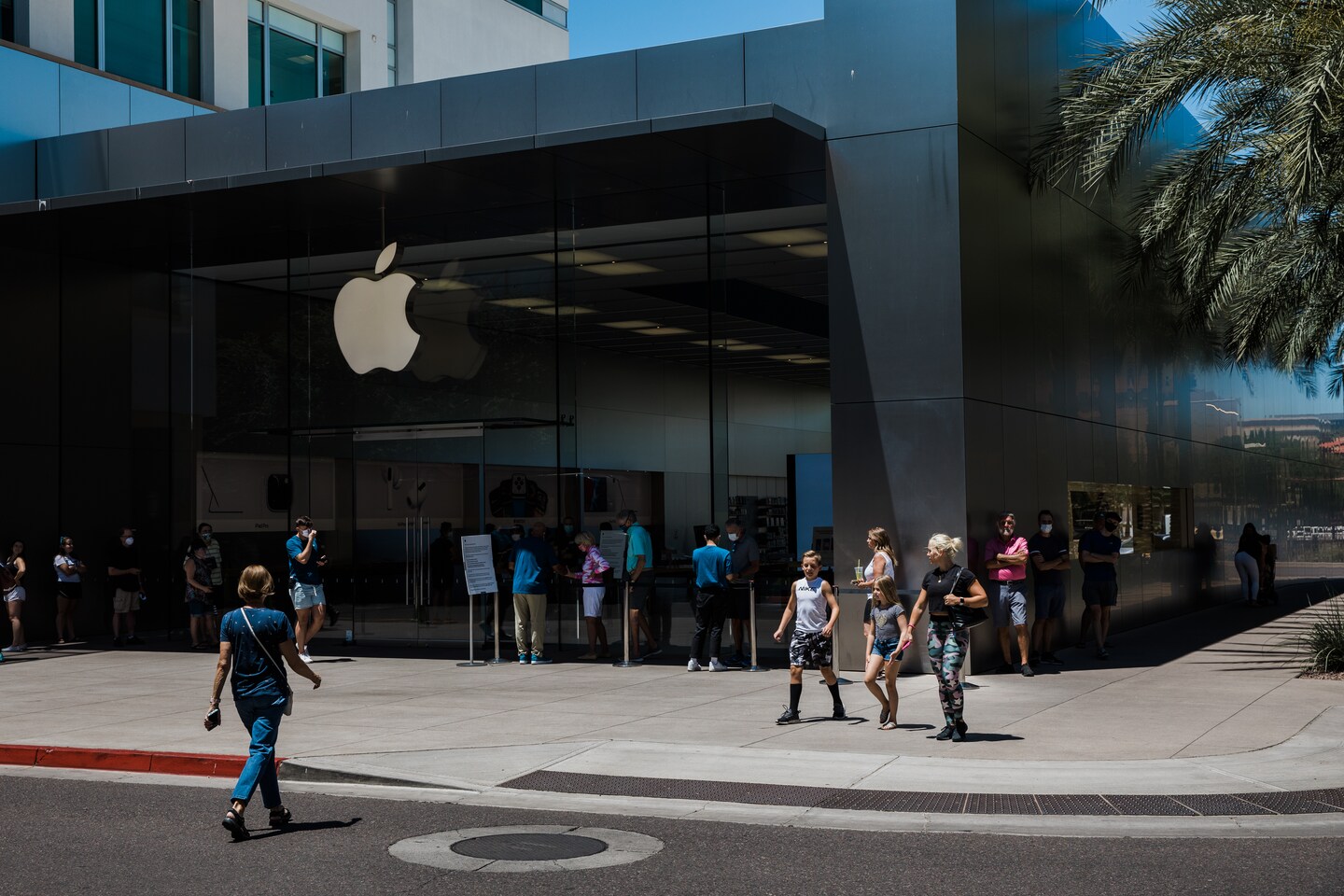Goodbye, Apple stock swings. Why investors can expect less fluctuation from the new Dow Jones industrial average.

We’ll also see how despite throwing out three of its 30 stocks after the market closed Friday, adding three new stocks and subtracting three-quarters of the value of Apple, its highest-priced stock, the Dow opened Monday at the same number — 28,653.87 — at which it closed on Friday.
How did the Dow manage to make all those changes at one time and remain unchanged before Monday’s market opened? It has to do with something called the Dow divisor, which we’ll discuss in a bit.
We’ll also see how the Apple adjustment cost the Dow almost 90 points on Monday compared with how much the equivalent increase in Apple’s price would have added to the Friday Dow.
The Dow, founded in 1896 with 12 stocks, is a simplistic indicator: It’s based on the total share prices of its now 30 components. It’s not based on the stocks’ total market value, the way the less popular but much more important Standard & Poor’s 500 index is. The fact that the S&P is based on market values and the Dow is based on share prices is why the S&P has trillions of dollars of investments indexed to it, compared with which the $30 billion or so tied to the Dow is barely a rounding error.
Let me explain.
When the Dow was created 124 years ago, there was no such thing as a computer and no way to figure out stocks’ total market values quickly. The only numbers that business reporters Charles Dow and Edward Jones could come up with in real time were the prices of the stocks they selected for their market indicator.
Beginning in 1928, the Dow got more sophisticated and began using something called the Dow divisor to adjust for stock splits and for changes in the stocks that make up the Dow, all without affecting the Dow’s price.
So let me show you, step by step, how the Dow adjusted itself for Friday’s changes, using numbers that I got from Howard Silverblatt, senior index analyst at S&P Dow Jones Indices.
Ready? Here goes.
When the market closed Friday, the prices of the 30 stocks then in the Dow totaled $4,177.68. (I could have gotten that number myself, but I cheated by asking Silverblatt for it.) The Dow divisor was 0.14579812. Divide the price total by the divisor, and you get Friday’s closing Dow: 28,653.87.
We start with $4,177.68. Now, the fun begins:
We subtract $40.69, ExxonMobil’s closing share price, because it was tossed out of the Dow effective after Friday’s close.
We add $271.10, Salesforce.com’s closing price, because it replaced Exxon Mobil.
We subtract $37.91, because Pfizer was tossed out.
We add $253.12, because Amgen replaced Pfizer.
We subtract $62.24, because Raytheon was tossed out.
We add $168.38, because Honeywell replaced Raytheon.
And, finally, we subtract $374.42. That’s 75 percent of Apple’s closing price on Friday, after which Apple’s 4-for-1 stock split took effect, reducing Apple’s share price to $124.81 from $499.23. (The lower price didn’t affect Apple shareholders, who ended up with four shares for each share they started with. But it affected the Dow, which is based on companies’ share prices, not their total market values.)
If you’ve done your arithmetic right, you’ll see that the share prices of what we’ll call the Revised Dow add up to $4,355.02.
We divide 4,355.02 by 28,653.87, the Dow’s closing price on Friday, and we get a Dow divisor of 0.15198715.
This means that beginning Monday, each $1 change in any Dow component moves the average by 6.58 points. (You get that number by dividing 1 by 0.15198715.) On the Old Dow, each $1 change moved the average by 6.86 points, because the divisor was 0.14579812.
I could show you how to create your own synthetic Dow. For example, we could celebrate Warren Buffett’s 90th birthday by adding Berkshire Hathaway B shares to the Dow and tossing out the Dow stock of your choice. But I don’t want to risk turning fun with numbers into math torture and having your eyes glaze over.
Instead, I’ll offer you one final thought, courtesy of Silverblatt. On Friday, Apple, one of the hottest big stocks on the face of the earth, accounted for 11.95 percent of the Dow’s value, making it the biggest component by far. After all the number shuffling, Apple was down to 2.87 percent and was only the 18th-largest component.
On Monday, we got an excellent example of Apple’s diminished Dow importance. Its $4.23 gain on Monday added 27.83 points to the Dow. The equivalent $16.92 pre-split gain would have added 116.05 points to Friday’s Dow.
So, you see, the recent maneuvers greatly diminished Apple’s future influence on the Dow. Even the Dow divisor can’t change that.






